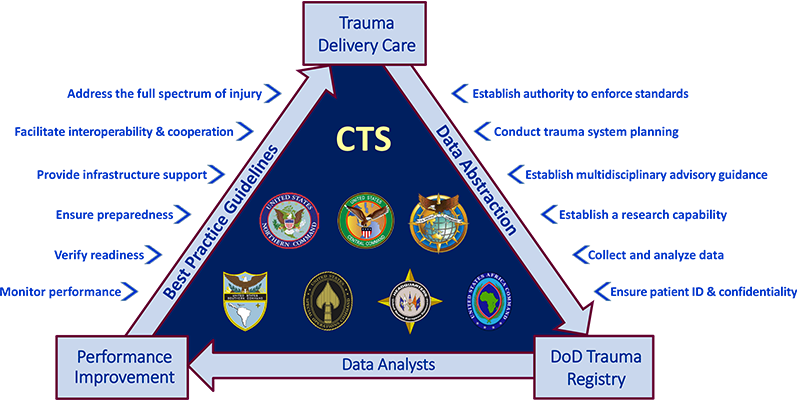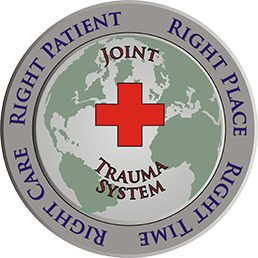JTS Operations
NOTE: Site under Development.
JTS advises and enables the establishment of scalable Combatant Command Trauma Systems (CTS) to provide optimal care for trauma patients and increase survivability.
12 Core Functions of the CTS & the JTS Operational Pyramid

The Operations Branch was founded to advise and enable the establishment of regional CTS which can be scaled to deliver casualty care and performance improvement (PI). Operations supports the Joint Trauma System leadership in its mission to directly support Combatant Commanders (CCDRs) across a full range of military operations which includes combat operations, post-conflict operations, or other contingency operations as directed. Support of CCDRs is pursuant to DoD Instruction (DoDI) 6040.47, Joint Trauma System (JTS), 28 Sep 2016, under the authority, direction, and control of the Under Secretary of Defense for Personnel and Readiness through the Assistant Secretary of Defense for Health Affairs.
The CTS is a trauma system informed by the Combatant Command (CCMD) Surgeon which operates under the authority, direction, and control of the CCDR. A trauma system allows for standardization of care, development of clinical benchmarks, PI, communication (secure and non-secure), transport, and treatment networks that optimize patient outcomes, resource utilization, and data-driven decision making. An effective CTS designed to optimize combat casualty care will improve outcomes for disease and non-battle injury, which historically constitute the majority of casualties in wartime and peacetime.
JTS supports the CCDR and CCMD Surgeon to establish a CTS which assists in trauma system planning, treatment, management, and improvement of casualty outcomes to include battle injuries, disease non-battle injuries and all-hazard settings through evidence-driven PI. The JTS, through the Assistant Director Combat Support (AD-CS), DHA, provides direct support to CTS planning and operations through the use of the DoD Trauma Registry, trauma system subject matter experts, PI capabilities, clinical practice guidelines, minimum Joint Standards for trauma training, the Defense Committees on Trauma, and the JTS training and readiness programs.
JTS Operations will advise in the development and maintenance of the 12 core functions of the CTS as described in the CTS DHA-PI 6040.06. Ideally, during Phase 0 operations, the establishment of the CTS construct will allow the CCDR to be prepared to provide optimal care for trauma patients, as well as casualties of disease and all-hazards response, with the ability to scale to meet CCMD requirements during standard military and contingency operations. The Operations team operates with the developmental guidance, operational support, and clinical oversight of the JTS in the JTS' capacity as the reference body for all trauma care across the Defense Trauma Enterprise. Below are some of the ways the JTS Operations supports CTS implementation and maintenance.
- Establish and fund a CTS Assessment Team capability that is able to deploy to conduct trauma system assessments, providing CCDRs feedback on current capabilities, gaps, and mitigation strategies.
- Prioritize CTS support to enable the expedited execution of critical or time sensitive CCDR requirements.
- Develop technical guidance, regulations, and procedural instructions for the DoD Components in the administration of casualty care delivery.
- Conduct PI and support activities to provide feedback to the field on the appropriate evaluation, treatment, and transportation of trauma casualties in support of a full range of military operations.
To learn more about how JTS supports CCMDs, read the JTS Concept of Operations for the Combatant Command Trauma System, 24 Oct 2020.

